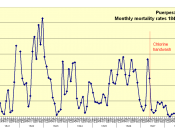Nosocomial Infections
Nosocomial infections are diseases or infections that health care professionals give to their patients. The term "nosocomial infection" should not be limited to just the hospital setting. People who reside in nursing homes or who have had short-term procedures have also been found to develop infections due to the same spectrum of pathogens.
The concept of infection control was originated by the work of Ignaz Semmelweis. During the 1840's he was working in Vienna General Hospital where there were two wards for birthing. One ward was staffed by medical students and the other entirely by midwives. Semmelweis noticed that women were much more likely to die if they delivered on the floor with the medical students, than by the ward attended by midwives. The death rate on the medical ward was 10 % while it was only 3 % on the midwife ward.
When Semmelweis investigated the procedures in each unit, there were no differences worthy of being noted, except the fact medical students staffed that one ward.
He concluded that the medical students were carrying "cadaveric material" from the dissecting classrooms on their hands and this was what led to the deadly infections. He insisted on the protocol of strict handwashing in chlorine water after dissection before moving to the delivery ward. This led to a dramatic reduction of the mortality rate.
The National Nosocomial Infections Surveillance system has done reports on random hospitals over the last 25 years. It was found that the infection rate remained stable with 5-6 infections out of every 100 admissions. However, there has been an increase from 7.2 to 9.8 from 1975 to 1995, which costs an estimated $4.5 billion and contributed to more than 88,000 deaths. These numbers increase with each passing year.
It is believed that 80% of...


